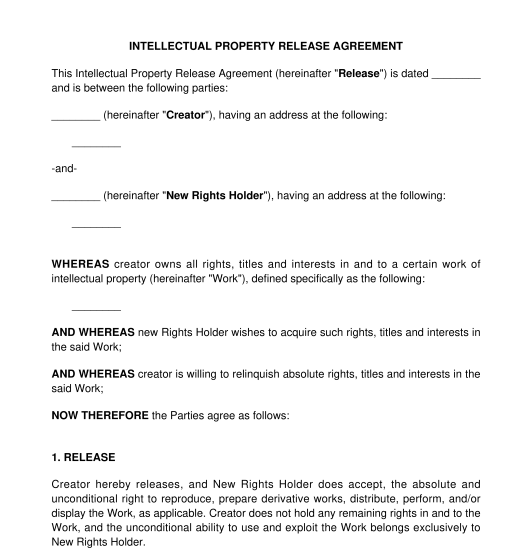 01/09/2025
01/09/2025

Answer a few questions and your document is created automatically.

Your document is ready! You will receive it in Word and PDF formats. You will be able to modify it.

 01/09/2025
01/09/2025
 Word and PDF
Word and PDF
 2 to 3 pages
2 to 3 pages
An Intellectual Property Release Agreement (sometimes just called a "Release") is a document by which someone releases something they created - like a work of art, writing, or a film - and gives away all the rights to someone else. The creations are called works of intellectual property, and by releasing the rights, the creator gives up any control over what happens to the intellectual property.
An intellectual property release should include the parties' identification, a description of the intellectual property, including whether its a trademark, patent, or copyright, the consideration (payment for the rights), and other conditions of the release.
An intellectual property release is different from a licence agreement. In a licence, the artist or owner of the work maintains all of their rights but allows another to use their work for the payment of royalties and subject to certain terms.
In a licence, the intellectual property holder still owns the intellectual property, they are simply allowing others to use certain aspects of those rights. On the other hand, in a release, the owner gives up (assigns) the rights in the intellectual property and no longer owns it.
A major prerequisite to an intellectual property release is that the releasor must be the actual owner of the intellectual property. Someone who has a licence cannot release any rights in the property. If there are multiple owners, each owner will need to consent to the release of the property.
An entity who owns the intellectual property and the new rights holder can enter into an intellectual property release agreement. The owner and the new rights holder can be a corporation, partnership, or other type of business entity. The signatories to the agreement must be of majority age and not under a disability. The ages of majority are as follows:
Once the form is ready, each party will need to sign it, either electronically or physically. Each party will need to keep a signed copy for their records and should upload a signed copy to their personal computer. Afterwards, it's important for each party to monitor the situation to ensure no disputes arise.
Yes. If the new rights holder is acquiring a patent or trademark, they will need to register their ownership with the Canadian Intellectual Property Office, which contains a database with all the owners of intellectual property and offers intelletual property protection.
Intellectual property in Canada is governed by federal law, with the main statutes being the Copyright Act (R.S.C., 1985, c. C-42), the Trademarks Act (R.S.C., 1985, c. T-13), and the Patent Act (R.S.C., 1985, c. P-4). It is best practice to include as much detail about the work as possible, in the Intellectual Property Release Agreement, so that if a dispute should arise, the rights to the specific work are clear.
You fill out a form. The document is created before your eyes as you respond to the questions.
At the end, you receive it in Word and PDF formats. You can modify it and reuse it.
Intellectual Property Release Form - Sample, template
Country: Canada (English)